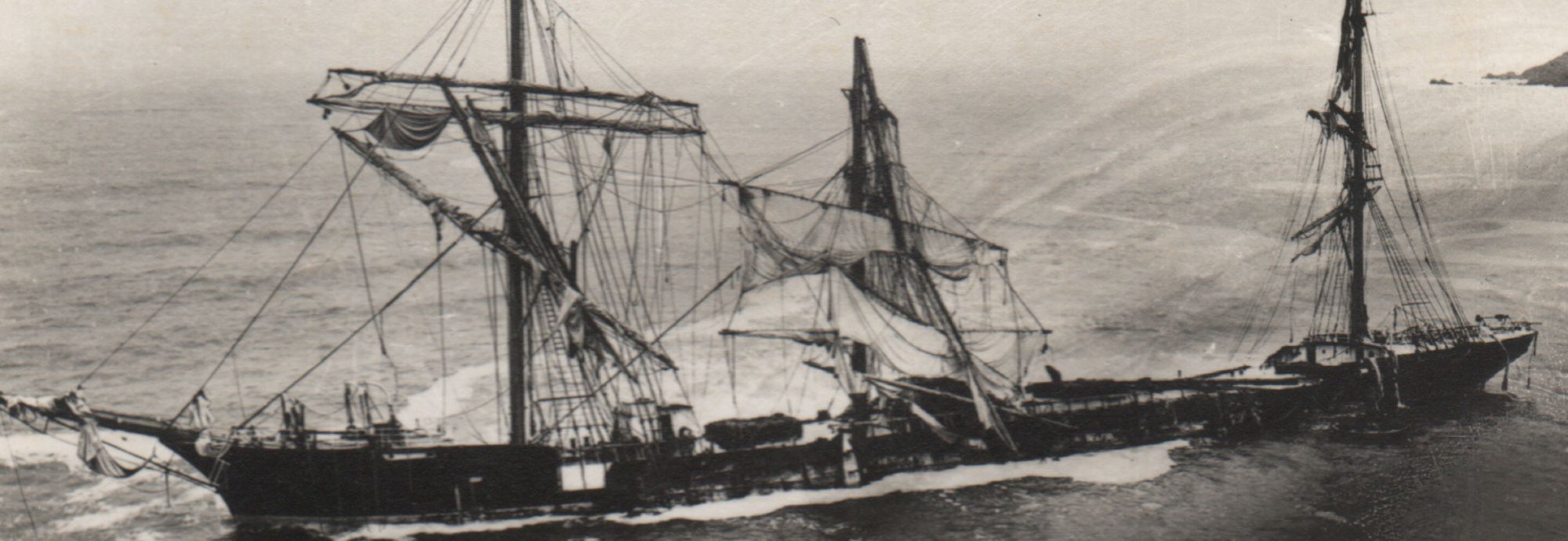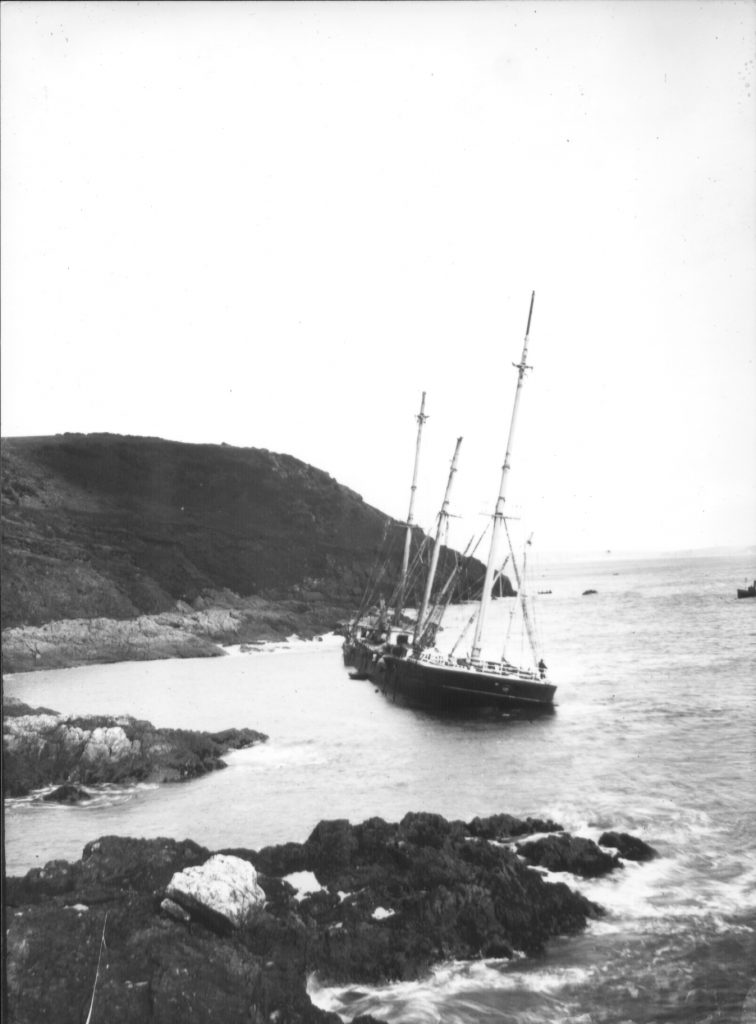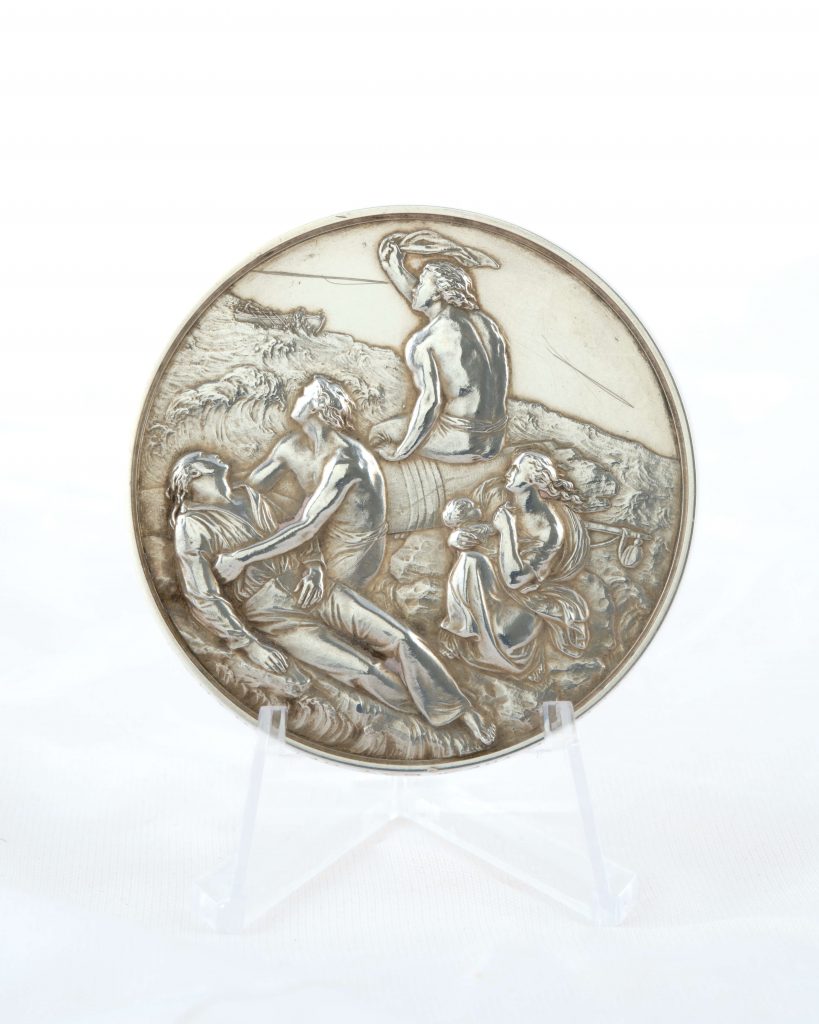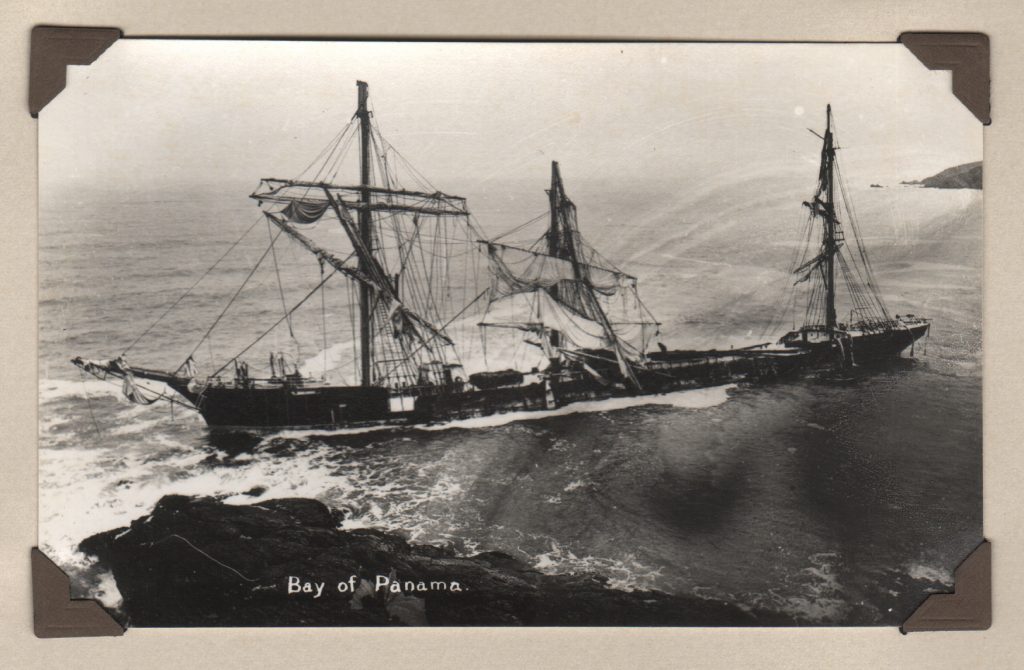

By Dr Jenny Lee
Cornwall experienced the worst blizzard in 200 years in March 1891, wrecking four ships on the Manacles, a treacherous group of rocks off the Lizard peninsula. One of these ships was the Bay of Panama. Described as one of the finest sailing vessels ever, this square-rigged steel ship was returning from Calcutta, where it had picked up 13,000 bales of Jute bound for Dundee.
When the weather began to deteriorate quickly, Captain David Wright took deep soundings, leading him to believe that he was close to the Lizard. The crew first noticed blizzard warnings at dawn on the 9th March; by 4pm, there was driving snow and a strong north-easterly gale. The Bay of Panama sent out a distress flare at 11:30pm as they thought they saw a steamship, but there was no response.
Two hours later, in the early hours of the 10th March, a large wave crashed onto the poop deck and completely turned the ship around. Moments later, amidst driving snow and zero visibility, the ship crashed head-on into the cliffs of Nare Point, swinging her round until her bow pointed east and listing heavily to starboard.
One mast broke off and fell into the sea, along with the fore and main topmasts, as the ship swung around until her bow pointed east and listed severely to starboard.
Before being carried overboard by a wave that swept along the deck, the second mate was able to launch a distress rocket. Captain Wright, his wife, the cook, the steward, and four apprentices were all washed over the side and drowned when the same wave swept through the cabin.

A photo of the Bay of Panama wreck from the NMMC archives.
To escape the icy waters that now engulfed the deck, the mate ordered the rest of the crew to climb the rigging. However, this was not without danger, as the sea spray soaked the men and the ropes before turning to ice. The sea spray, however, soaked the crew’s clothes and the ropes before freezing. Many lost their grip and fell into the sea, while at least six men froze to death.
On the 10th March, as dawn broke, a local farmer searching the cliffs for his sheep, discovered the wreck. The ship’s side was on the sea and her bowspit less than 50 feet from the rocks. The masts had been destroyed and were trailing behind, along with the sails and cordage. Some of the crew were clinging on to the rigging, some of whom were dead and others who were still alive.
The farmer quickly notified the coastguard in Porthallow, who set out from St Keverne with rocket apparatus. By 9am, 17 survivors had been brought ashore from a crew of 40. Due to the low temperatures and the fact that their clothes having frozen stiff, they had to be lifted from the rigging and placed in the breeches-buoy with their limbs in the position they were found. The body of the captain’s wife was the first to be recovered from the sea.
William Fisher, to whom this medal was awarded, was in charge of the coastguards, while his wife was in charge of taking the survivors back to St Keverne to get some food and rest, but also to thaw them out.
The remaining crew needed to contact Falmouth urgently to report on the state of the ship and its cargo, but the blizzard had also damaged the telegraph lines. They took a horse-drawn omnibus from St Keverne heading for Falmouth the day after their rescue. However, large snow drifts blocked the road, forcing them to abandon their transport and walk the remaining distance, some without shoes. According to The Falmouth Packet, those on this harrowing journey ‘endured as much privation in that walk as they did in the actual shipwreck.’

A silver medal awarded to William Barker for his bravery in saving lives at sea during the Great Blizzard of 1891. Barker was one of the three men who crossed on the breeches buoy to rescue the crew of the Bay of Panama, which was shipwrecked off the coast of the treacherous Lizard Peninsula. It has a very intricate scene of a shipwreck, reminiscent of The Raft of the Medusa by Géricault. It’s on loan to NMMC from the Barker family.
The medal shows a bust of Queen Victoria and, on the reverse, a very intricate scene of a shipwreck, reminiscent of The Raft of the Medusa by Géricault. The medal was designed by Benjamin Wyon, who came from a large and illustrious family of engravers and medallists. This medal can be found in our ‘Cornwall and the Sea’ gallery, which includes a photograph of the wreck in the panels.
The following account, an excerpt from a letter dated 11 March 1891, was recently donated to the Museum:
Dear John,
I left work early on Monday afternoon to write you and one or two more, it being very cold and blowing from the east, not being busy I thought too cold to work in ships. I had no sooner changed and got before the fire smoking cigarette than word came that the rocket apparatus was wanted at Porthoustock. So everybody was all astir As you well know what excite- ment those things make. The journey there was terrible The wind was an hurricane with blinding snow. But sad, sad to say arrived just 20 min too late the vessel, a ketch struck the rocks and was nothing but floating wreckage in five minutes Lots on the cliff around provided no assistance the men in the vessel struggled bravely but what could they do in such a sea 4 were drowned this was in Porthkerris. No doubt you know the place.
Another ketch within sight her about 200 fathoms nearer Porthoustock went ashore and was in matchwood in about 10 minutes and her crew too perished the crew struggled bravely but what could they do in such a cruel sea that was an hour before we got on the scene. In Porthoustock Cove there was another but her crew were saved, some came back sad that we were just too late. There is no doubt blame to some one we ought to have known it an hour before and no doubt we should have saved at least the crew.
But I have sadder news to tell you in the following morning word came from Porthallow for Rocket Apparatus. I need not tell you of the awfulness of the journey there. It was indescribably terrific with snow inches deep. When we got there one of the saddest sights seen that human eyes can behold met us. A large fourmast ship called the Bay of Panama 3 of the men hanging lifeless in the rigging 2 on the poop dead, 17 poor Fellows whom we rescued with apparatus on the forecastle Did they not send up a shout when they saw us. We very soon had them ashore.
She came there about 2 in the morning 19 of the crew drowned including every officer and the captains wife and baby. About Agency you would perhaps be wondering whether I have it or not. I don’t know Mr Roskilly sent two messengers on horseback they both came back unable to proceed and sent one which arrived at Broad’s office this morning 9 o’clock where it was all night I don’t know I went to wreck this morning.
Broad’s in steamer Came there about 12 o’clock Came away soon as my messenger arrived but all telegraphic communication is stopped wires broken down so they could not say anything about it. There are many other incidences with the sad occurences but they would take up too much time to write though I know you would be interested. Cannot go in to many details in letters I am very sorry you have been so ill. I hope you were well enough to go to work as you expected.

A photo of the Bay of Panama wreck from the NMMC archives.
Ran aground
Wrecked
Reported lost

National Maritime
Museum Cornwall Trust
Discovery Quay
Falmouth Cornwall
TR11 3QY
View Map
See our opening hours
Tel: +44(0)1326 313388
Email: enquiries@nmmc.co.uk